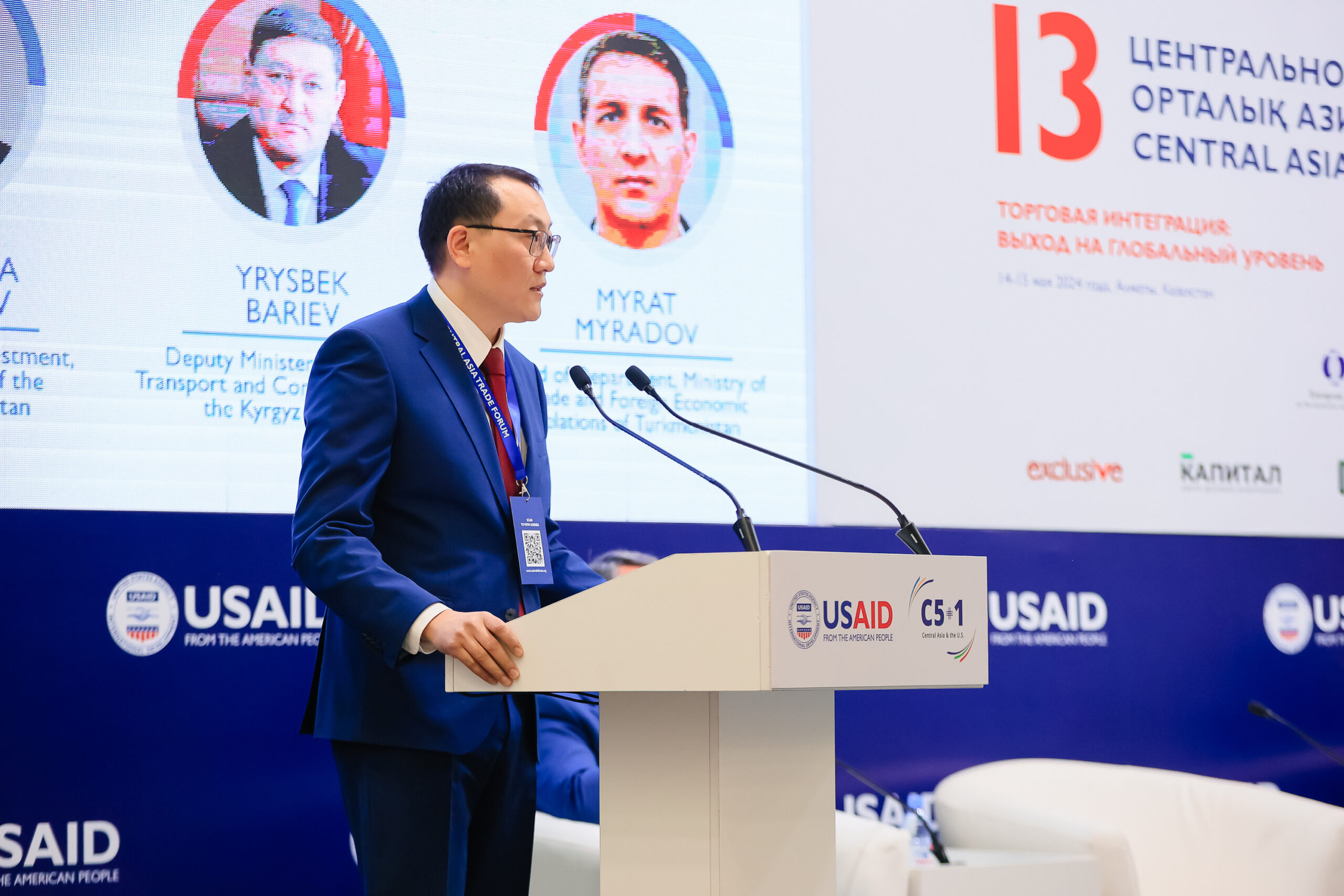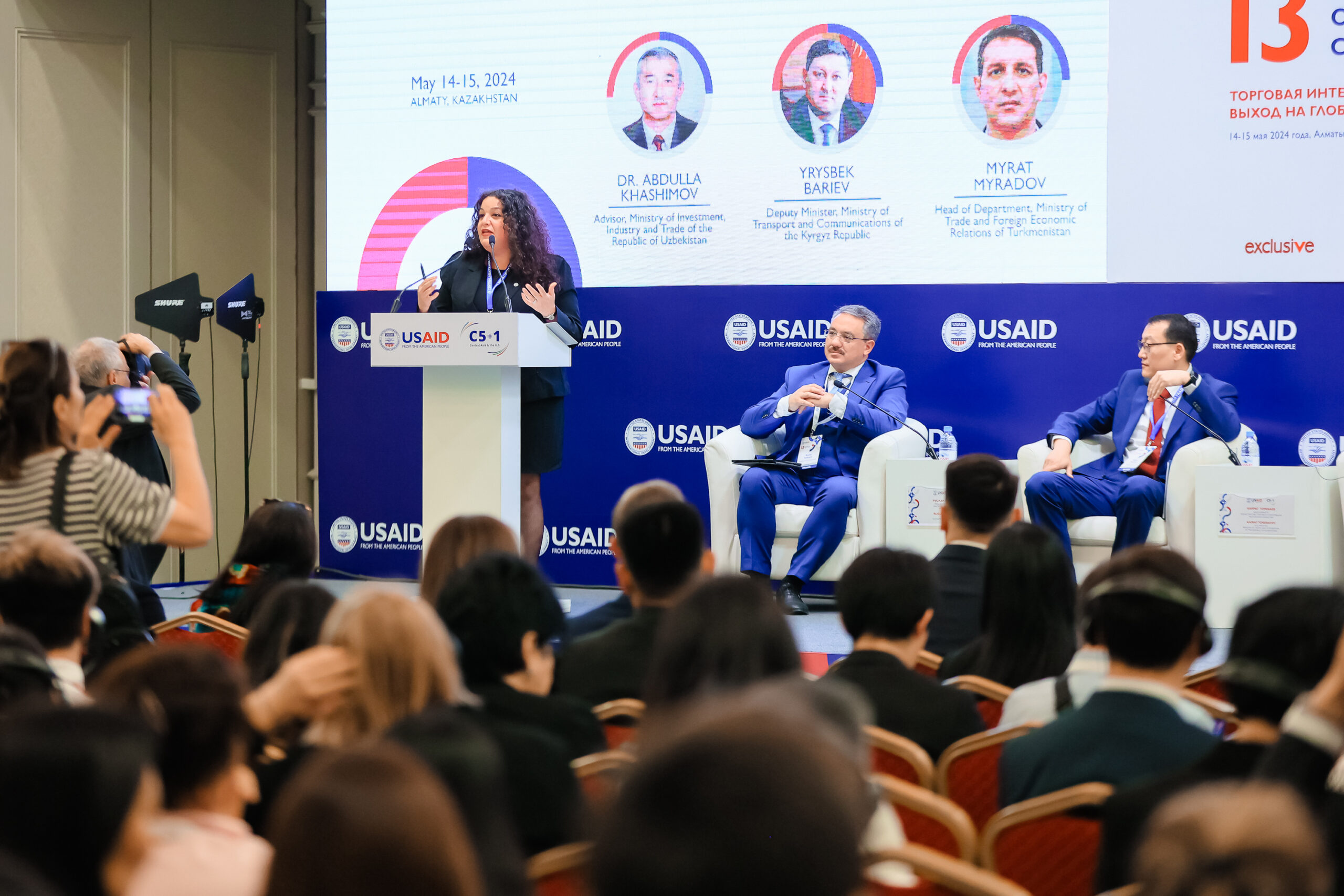ALMATY — The 13th Central Asia Trade Forum kicked off in Almaty on May 14 with a resounding call to enhance trade across Central Asia to catalyze regional prosperity.

The ministers from Central Asia’s countries outlined strategies to improve transport infrastructure to catalyze regional prosperity at the plenary session on May 14. Photo credit: USAID.
The panel included Zeinah Salahi, the senior Deputy Assistant Administrator of the U.S. Agency for International Development’s (USAID) Asia Bureau in Washington, Kazakh Vice Minister of Trade and Integration Kairat Torebayev, Abdulla Khashimov, an advisor to the Ministry of Investment, Industry and Trade of Uzbekistan, Yrysbek Bariev, the Kyrgyz Deputy Minister of Transport and Communications and Myrat Myradov, the head of the Department for Legal Regulation and Coordination of Foreign Economic Relations at the Turkmen Ministry of Trade and Foreign Economic Relations.
Fostering collaboration and unleashing trade potential
Moderating the session, Ruslan Sultanov, the chairman of the Economic Research Institute, underscored the crucial interplay between proactive business initiatives and supportive governmental policies. He stressed that when businesses are willing to cooperate, governments are ready to lend their support, thus fostering a conducive environment for trade and investment.

Vice-Minister Torebayev highlighted in his address Kazakhstan’s prowess in paperless trade facilitation, surpassing the global average in key parameters. Photo credit: USAID.
“The initiative often originates from the grassroots level. If businesses are eager to collaborate, government agencies will step up,” Sultanov said.
Central to the discussions was the vast untapped potential for trade within the region. Salahi, representing USAID, lauded the ongoing collaborative efforts, emphasizing the significant strides in trade volumes over the years. She also highlighted advancements in customs digitization through the reduction in clearance times at key border crossings and underscored the tangible progress catalyzed by concerted endeavors.
“The last Central Asia Trade forum focused on customs digitization, and since then, we have seen quite a lot of progress. For example, the average clearance time per vehicle is down by 18% at the Yallama-Konysbayeva border crossing between Uzbekistan and Kazakhstan thanks to process improvements,” she said.

Zeinah Salahi, the senior Deputy Assistant Administrator of the USAID Asia Bureau in Washington, addressed forum participants on May 14. Photo credit: USAID
Salahi reiterated the imperative of digital transformation in streamlining trade processes, propelling the region towards paperless trade and facilitating seamless connectivity along the Trans-Caspian Trade Route (TITR).
Embracing digital transformation
Digitalization emerged as a recurring theme, underscoring the urgent need for harmonized trade norms and streamlined processes. While commendable progress has been achieved, participants acknowledged the imperative of refining existing frameworks to address persisting challenges.
Vice Minister Torebayev highlighted in his address Kazakhstan’s prowess in paperless trade facilitation, surpassing the global average in key parameters. He pointed out that according to the United Nations Global Study on Trade Facilitation using Digital and Sustainable Technologies, the country has consistently outperformed other developing countries in nearly all aspects of paperless trade in recent years. Additionally, Kazakhstan has significantly enhanced its overall trade facilitation indicator to over 76%.
“Kazakhstan has achieved a high level of implementation in various measures such as an automated customs system, an electronic ‘single window’ system, and the submission of customs declarations in electronic form, along with electronic payment of customs duties and fees. These advancements align with standards seen in developed countries worldwide,” he said.
Torebayev emphasized the indispensable role of robust transport, logistics, and trade infrastructure in successfully executing trade projects, underscoring the pivotal significance of bolstering intra-regional trade for driving prosperity in Central Asia.
He noted the strengthening partnership between the Kazakh Ministry of Trade, QazTrade Trade Policy Development Center, and the USAID program, culminating in tangible outcomes such as the National Export Review report and the development of a comprehensive roadmap aimed at enhancing Kazakhstan’s export potential through multifaceted approaches including infrastructure modernization, institutional reforms, and digital integration. He also highlighted the notable achievements of the USAID Trade in Central Asia program, which has played a pivotal role in simplifying trade procedures and strengthening the export ecosystem.
Strengthening regional connectivity and joint market expansion
In line with the broader regional objectives, ministers outlined strategies to enhance transport infrastructure, which are crucial for facilitating trade flows and unlocking the region’s economic potential.
Kyrgyz Deputy Minister of Transport and Communications Bariev emphasized the pivotal role of digital reforms alongside physical infrastructure enhancements.
“Central Asia will benefit if there is mutual recognition of documents such as transit declarations and invoices and mutual recognition of electronic digital signatures. In Central Asia, particularly in the Kyrgyz Republic, digital reforms in transport and customs sectors are ahead of updates in physical infrastructure,” he said.
According to Khashimov, an advisor to the Uzbek Ministry of Trade, the Central Asian region witnessed notable strides in trade volume last year. The share of Central Asian countries in Uzbekistan’s foreign trade surged to 11.5%, reaching $7.2 billion in 2023, a substantial increase from 6.4% recorded in 2022.
The continuous modernization of transportation and communication infrastructure has played a pivotal role in facilitating trade activities over the years. However, there is still a need to combine cooperation efforts and conduct an in-depth analysis of the potential for joint entry into other markets.
“The combined trade volume of Central Asian countries with Iran, Afghanistan, and Pakistan reached $7.1 billion. The joint work can lead to expansion of trade, particularly in high-demand markets like India and Pakistan,” said Khashimov.
He highlighted proactive initiatives, including establishing the International Industrial Development Center between Kazakhstan and Uzbekistan, alongside efforts to enhance railway transport and border crossing points. According to him, Kazakhstan’s pivotal role in facilitating railway import-export transit cargo, accounting for approximately 80%, underscores the significance of cross-border collaboration.
Khashimov noted that with Central Asia’s population surpassing 80 million and a total GDP of $446 billion, there is optimism that the Central Asia Trade Forum will play a pivotal role in fostering regional development, leveraging competitive advantages, and promoting deeper integration across diverse sectors.
Myradov, representing Turkmenistan, emphasized the country’s nascent digital transformation and commitment to integrating into global trade processes and leveraging its robust transport infrastructure. The country’s goal to foster a digital economy aligns with broader regional objectives, aiming to position Central Asia as a hub for trade and transit.
As the CATF continues its work tomorrow, participants are united in the belief that collaborative efforts are pivotal in unlocking Central Asia’s immense economic potential, paving the path for shared prosperity and integration into global trade.


